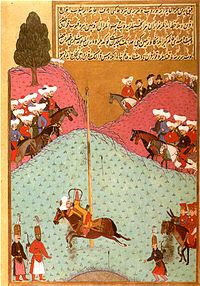Murad la 2-a
| Murad la 2-a | |||||
|---|---|---|---|---|---|

| |||||

| |||||
| Persona informo | |||||
| مُراد ثانى | |||||
| Naskiĝo | 31-an de majo 1404 en Amasya | ||||
| Morto | 3-an de februaro 1451 (46-jaraĝa) en Edirne | ||||
| Tombo | Muradiye Complex (en) | ||||
| Religio | islamo vd | ||||
| Lingvoj | Osmanida turka • araba • persa vd | ||||
Subskribo 
| |||||
| Familio | |||||
| Dinastio | Otomana dinastio vd | ||||
| Patro | Mehmed la 1-a | ||||
| Patrino | Emine Hatun (en) | ||||
| Gefratoj | Küçük Mustafa (en) | ||||
| Edz(in)o | Mara Branković (en) Hüma Hatun (en) Tacünnisa Hatice Halime Sultan Hatun (en) | ||||
| Infanoj | Mehmedo la 2-a ( Fatma Sultan (en) ( | ||||
| Profesio | |||||
| Okupo | reganto | ||||
| |||||
| vd | Fonto: Vikidatumoj | ||||
Murad la 2-a (en Otomana turka: مراد ثانى, latinigita: Murād-ı sānī, en turka: II. Murat, portanta la titolon Ghazavat-ı Sultan Murad,[1] en Otomana turka: غزوات سلطان مراد, latinigita: Gazavât-ı Sultan Murad)[2] n. 16a de junio 1404[3][4] – 3a de februaro 1451) estis la Sultano de la Otomana Imperio el 1421 ĝis 1444 kaj denove el 1446 ĝis 1451.

La regado de Murad la 2-a estis markita de longa milito kiun li luktis kontraŭ la kristanaj feŭdaj senjoroj de Balkanio kaj la tjurkaj bejlandoj en Anatolio, konflikto kiu daŭris 25 jarojn. Li estis alportita en Amasia, kaj ascendis al la trono post la morto de sia patro Mehmed la 1-a.
Notoj
[redakti | redakti fonton]- ↑ Sohail H. Hashmi, (2012), Just Wars, Holy Wars, and Jihads: Christian, Jewish, And Muslim Encounters And Exchanges, p. 195
- ↑ [1] Halil Inalcık, Gazavât-ı Sultan Murad
- ↑ "Murad II | Ottoman sultan". Encyclopedia Britannica.
- ↑ محمد فريد; حقيق: الدُكتور إحسان حقّي (2006). تاريخ الدولة العليَّة العُثمانيَّة. Beirut - Libano. p. 153.
Bibliografio
[redakti | redakti fonton]- Creasy, Edward (1878). History of the Ottoman Turks; From the beginning of their empire to the present time.
- Babinger, Franz (1978). Mehmed the Conqueror and His Time. Bollingen Series 96. Tradukita el la germana de Ralph Manheim. Eldonita de William C. Hickman. Princeton, New Jersey: Princeton University Press. OCLC 164968842.
- Harris, Jonathan, The End of Byzantium. New Haven and London: Yale University Press, 2010. ISBN 978-0-300-11786-8
- Imber, Colin, The Ottoman Empire. London: Palgrave/Macmillan, 2002. ISBN 0-333-61387-2
Text is available under the CC BY-SA 4.0 license; additional terms may apply.
Images, videos and audio are available under their respective licenses.


